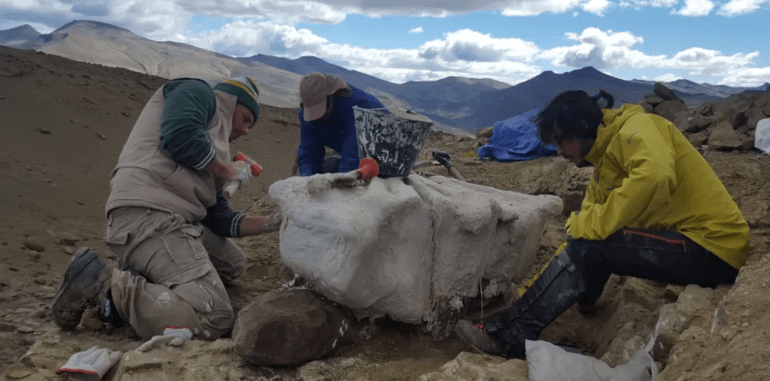Paleontologists at the University of Chile in Santiago have discovered the remains of a 'extremely bizarre' ankylosaurus with a deadly armored tail unlike any other known dinosaur.
This discovery was presented in a new research paper published in the famous scientific journal "Nature" on the first of December, and the study showed that this "very strange" dinosaur that was newly discovered, and roamed Chile 75 million years ago, was frightening. And armed with an overwhelming weapon consisting of a deadly and dangerous armored tail.
"The tail could have looked like a sword, it's very flat," study co-author Alexandre Vargas, a vertebrate paleontologist at the University of Chile's Department of Biology, told Live Science.
It would have looked a bit "like an Aztec sword, or 'maquahuttle'", a first-millennium wooden weapon with several sharp blades, and on either side of it had obsidian blades capable of producing iron razors sharper than high-quality hard razors.
The scientific team prepared the plaster jacket to protect the fossils in the Magallanes region in Chilean Patagonia (Science Alert)
Journey to discover the terrifying dinosaur
Paleontologists have discovered the strange-looking new type of dinosaur in fossils that were found in the valley of "Rio de las Chinas" in the Magallanes region of Chile, South America, and the skeleton was well-preserved in the rocks of the Cretaceous period - dating between 71.7 million and 74.9 million years ago. 1 year - 80% complete.
The researchers called it "Stegouros elengassen", and it is about two meters long, and they described it as "strange", because it is articulated and its bones are arranged from the waist down, and everything from the waist up was somewhat scattered. "According to the research team, it appears That this dinosaur developed a large tail weapon unlike those of other dinosaurs, with serrated edges in a leaf-like arrangement.
It is possible that this herbivorous dinosaur was used to fend off small theropods and large predatory dinosaurs.
According to the study, the researchers said, "Armored dinosaurs are well known to have evolved specialized tail arms and paired tail screws in stegosaurus and heavy tail sticks in advanced ankylosaurs."
"Here we describe a complete semi-articulated skeleton of a small armored dinosaur from the late Cretaceous Magallanes in the extreme south of Chile, an area biogeographically linked to West Antarctica," they added.
"The monster died in a river, probably in quicksand, which explains why its lower half is so well preserved, although that's just a guess," Vargas said.
Paleontologists have found about 80% of the skeleton of a dinosaur (Science Alert, Francisco Huichelio)
When and where did the terrifying dinosaur live?
"Steguros" - who lived in a delta consisting of intertwined rivers that form islands between them, in addition to plants such as ferns and forests of "Nothophagus" trees - belongs to the "Ankylosaurs";
A group of herbivorous dinosaurs famous for their tank-like bodies and bat-shaped tail tips, which lived 70 million to 66 million years ago.
Researchers say that ankylosaurs are from Laurasia (the northern landmass of what was once the well-studied giant subcontinent of Pangea), however, those from southern Gondwana (the southern landmass of Pangaea thought to likely include the first species of Ankylosaurus) rare and poorly understood.
According to the team, stegoros lived in Gondwana during the late Cretaceous period (about 71.7 to 74.9 million years ago).
Analysis of the fossils showed that it possessed a large tail arm made of 7 pairs of flattened bony deposits that fuse together like a frond across the outside of its tail.
As for its skull, the dinosaur had features like those of other ankylosaurs, including a large head curved in proportion to the rest of the body.
However, researchers believe the rest of its skeleton is largely primitive, with some stegosaur-like characteristics.
Stegosaurs are famous for having double rows of large, triangular bony plates on their backs and a tail that may have been used to regulate temperature.
According to the genetics analyses, the researchers also revealed that the 'Steguros' was related to the 'Conparasaurus' dinosaur from Australia and the 'Antarctopilta' from the nearby Antarctic continent.
Conparasaurs is known for its armored back, which is similar in appearance to a modern-day armadillo, while Antarctopilta had spikes on its upper back.
Previously unknown story
In addition to revealing its armed tail, dinosaur remains tell a previously unknown story of ankylosaurus evolution. The disintegration of the giant subcontinent Pangea during the Jurassic period (201.3 million to 145 million years ago) led to stark differences between the ankylosaurs of the northern subcontinent of Laurasia and those of the northern subcontinent. Southern continent Gondwana, such a newly discovered species.
"It's exciting to find an armored dinosaur with a tail that has never been seen before," Vargas said.
"This is a new breed... a breed from the southern hemisphere that has developed a third type of tail weapon," he added.
"It's just extraordinary material and a really unexpected dinosaur," said Matt Lamana, a vertebrate paleontologist at the Carnegie Museum of Natural History in Pittsburgh who was not involved in the study.

